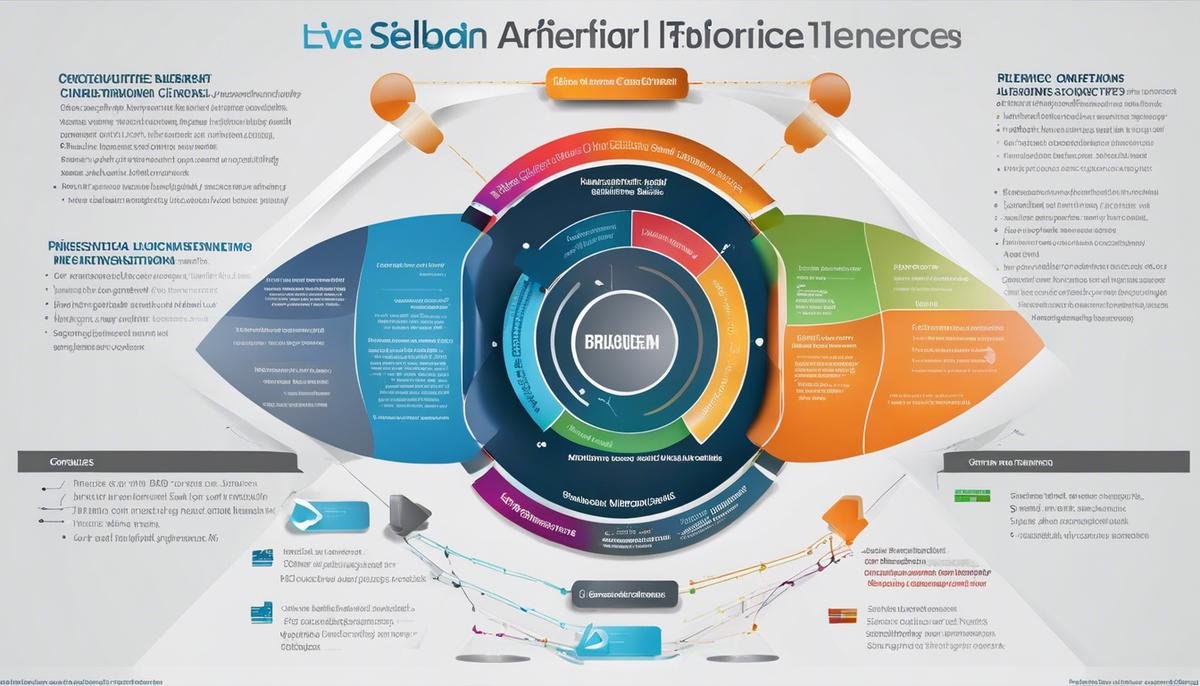Artificial Intelligence (AI) stands at the forefront of technological innovation, poised to reshape the world with its unparalleled capabilities. However, the ascent of AI ushers in not only advancements but also profound ethical considerations that demand our immediate attention. As we stand on the precipice of an AI revolution, it is imperative to engage in a rigorous examination of the ethical framework that will guide AI development and integration into the societal fabric. This essay embarks on a crucial journey through the realms of AI ethics, where the principles of human rights, justice, and transparency serve as the compass by which we navigate this uncharted terrain, hoping to ensure that our coexistence with AI remains beneficial, just, and honorable for every member of society.
Defining AI Ethics
The Core Ethical Considerations in Artificial Intelligence
As the domain of artificial intelligence (AI) burgeons, the onus to incorporate ethical principles into AI systems becomes ever more paramount. Concerns such as the abdication of responsibility and the implications of decision-making by non-sentient entities need to be meticulously addressed. Engaging with these concerns, the field has identified foundational principles that ought to guide ethical AI development and implementation.
Transparency: At the heart of ethical AI lies the principle of transparency. This entails the necessity for AI systems to be understandable by humans. Stakeholders should have access to information about the system’s capabilities, its decision-making process, and its limitations. This understanding underwrites the trustworthiness of AI solutions and assures that their operations are not ensconced in a ‘black box.’
Accountability: Bridging closely with transparency is the principle of accountability. There must exist clear pathways of responsibility for the decisions and actions of AI systems. Establishing accountability ensures that when AI systems are deployed, it remains possible to attribute responsibility for outcomes, both foreseen and unforeseen.
Fairness and Non-discrimination: AI systems must be constructed to provide equitable outcomes. This involves painstaking efforts to avoid biases that might result in discrimination against certain groups or individuals. It is crucial for AI systems to treat all users fairly, providing equal opportunity regardless of factors such as gender, race, or socio-economic status.
Privacy Preservation: AI systems often process vast swathes of personal data. Consequently, respecting and preserving user privacy is essential. Ethical AI must comply with all relevant data protection laws, ensure that data is secured, and that personal information is not misused.
Beneficence: This principle posits that AI should act in the best interest of individuals and society. AI systems should be designed to enhance human capabilities and wellbeing, avoiding harm and ensuring that the benefits are distributed throughout society.
Autonomy: In conjunction with beneficence, AI systems should respect and enhance the autonomy of human beings. AI should support individuals in making informed choices and should not undermine human decision-making capacity or manipulate people.
Robustness and Security: Ethical AI systems must be robust and secure. They should function accurately under a diverse range of conditions and safeguard against both inadvertent errors and malicious attacks that could cause harm.
By adhering to these foundational principles, the development of artificial intelligence could be steered towards an ethical trajectory. Ethical AI is not merely a theoretical construct but a cornerstone of building systems that are just, beneficial, and respect the dignity of all individuals affected by their operation. The cohesion of these principles provides a framework that guides researchers, developers, and stakeholders toward responsible innovation in the exhilarating realm of artificial intelligence.

Bias and Fairness in AI
Bias in artificial intelligence (AI) manifests when AI systems display prejudiced results or perpetuate societal stereotypes. This tends to occur due to biased data, flawed algorithms, or the misalignment of an AI system’s goals with equitable principles.
One commonly observed phenomenon is the reflection of historical biases present in the training data; AI algorithms are only as unbiased as the information used to train them. For example, if a facial recognition system is predominantly trained on images of individuals from a single racial background, it may be less accurate when identifying faces from other racial groups.
Another issue is algorithmic bias, where the design or the decision-making process of the AI inadvertently favors one group over another. Even with well-intentioned algorithm design, if the underlying model misinterprets data relationships, it can lead to biased outcomes. This can be exacerbated by automation bias—the propensity for humans to favor suggestions from automated decision-making systems without critical evaluation.
To ensure fairness in AI, interdisciplinary approaches are integral. A collective effort from computer scientists, ethicists, sociologists, and legal experts is necessary to dissect the complex nature of fairness. In practice, fairness can be approached by:
- Diverse Data Sets: Curating balanced and representative data sets is fundamental to train AI systems without inherent biases. Regular audits for data inclusion and batch testing different demographic segments are strategies to mitigate data bias.
- Adversarial Testing: Implementing processes that actively attempt to ‘fool’ AI systems can illuminate hidden biases. By testing AI against scenarios designed to uncover discrimination, engineers can rectify issues before they escalate.
- Explainable AI: Developing AI systems with interpretable decision-making processes allows humans to understand and trust AI outcomes. When the reasoning behind AI decisions is transparent, pinpointing bias becomes feasible.
- Continuous Monitoring: Fairness is not a one-off task but a continuous process. AI systems must be monitored and updated to remain fair as societal norms and values evolve.
- Ethical AI Frameworks: Ethical frameworks, policies, and guidelines can serve as a blueprint for developing and deploying AI technologies that prioritize fairness. These frameworks should be enforced through rigorous governmental and institutional regulations.
AI, by its nature, is a dynamic tool that mirrors the complexities of human society. Ensuring its fairness is an ongoing challenge that demands vigilance and an unwavering commitment to equal and just technological advancement.

AI Accountability and Responsibility
The Deliberation of Fault in Artificial Intelligence Missteps
In an era where artificial intelligence (AI) is progressively entwined with daily operations and decision-making, the question of liability when AI systems malfunction or result in detrimental outcomes is both critical and complex. This discourse endeavors to unravel the layers of accountability, extending beyond the underlying principles already established which include the importance of transparency and the continuous pursuit of AI that is fair, respects privacy, and benefits society as a whole.
At the core of this discussion lies the conundrum of ascribing fault in a landscape where human and machine collaboration is ubiquitous. AI systems, designed to learn and adapt, can develop unforeseen inaccuracies or flaws over time, influenced by the data they consume and the environment in which they operate. The determination of accountability, therefore, does not rest on a single entity but is shared among various stakeholders: creators, deployers, and regulators.
Creators, comprising of developers and researchers, bear the onus to ensure their AI systems are crafted meticulously, incorporating failsafe mechanisms and safety nets to mitigate the risk of unintended consequences. Deployers, who integrate these systems into real-world settings, are responsible for the diligent implementation and oversight of these technologies, guaranteeing that continuous updates are applied and that the AI’s performance aligns with the ethical standards preordained by society.
Regulators and policymakers play a pivotal role, setting the stage for how AI systems should be managed and how accountability is regulated. This demands the establishment and enforcement of laws and standards that clearly articulate the responsibilities and consequences associated with the deployment of AI systems. By crafting legislation that is specific to the unique characteristics and challenges of AI, regulators bridge the gap between technological advancement and legal structure.
Moreover, when considering the role of AI in high-stakes scenarios, such as healthcare or autonomous vehicles, the need for comprehensive insurance models arises to safeguard against potential liabilities. These models spread the financial risk and ensure that victims of AI errors are compensated while also incentivizing the improvement of AI systems.
In conclusion, attributing blame when AI errs is a shared responsibility involving the creators, deployers, and regulators, each with their distinct roles, bound by the overarching aim of developing AI that epitomizes reliability and moral integrity. As society continues to grapple with these unprecedented technological challenges, the collective effort and wisdom of these stakeholders are paramount in steering the course of AI towards a future that is both innovative and intrinsically responsible.

Privacy Concerns in AI
Artificial intelligence (AI) has emerged as a transformative technology, yet it presents equally significant concerns regarding individual privacy. In discussing the potential impact of AI on such privacy, it is crucial to consider additional protection measures that can safeguard personal information.
The integration of AI systems in daily life results in the collection and analysis of vast amounts of personal data. Smartphones, smart home devices, and online services utilize AI to personalize experiences, but in doing so, they may also track location, record voice, and monitor behavior. Such surveillance capabilities can lead to a loss of privacy if data is improperly accessed or used.
Data anonymization stands as a primary defense against privacy intrusions. By stripping away identifiable information, it reduces the risk that personal data will be linked to specific individuals. However, sophisticated AI algorithms may be able to de-anonymize data, calling for stronger and more innovative anonymization techniques.
Another protective measure is the enforcement of data minimization principles. AI systems should only collect data that is strictly necessary for the function they serve. This reduces the likelihood of sensitive information being captured and stored, which in turn minimizes vulnerability.
Consent mechanisms also play an essential role in protecting privacy. Individuals must have the ability to control what data is collected and how it is used. Opt-in and opt-out features, transparent data usage policies, and user-friendly consent processes empower users to protect their own privacy.
Moreover, encryption is a potent tool for safeguarding data. Strong encryption protocols can ensure that even if data is intercepted, it remains unreadable and secure from unauthorized parties. However, there is an ongoing debate about the balance between encryption and the needs of law enforcement.
Additionally, the design of AI must involve privacy by design principles. This approach integrates privacy considerations into the product development cycle from the very beginning, rather than as an afterthought. By doing so, AI systems are more likely to respect and uphold privacy standards.
Lastly, international cooperation is necessary to establish uniform privacy standards capable of matching the transnational nature of many AI applications and services. This includes harmonizing regulations and facilitating cross-border collaboration in enforcement.
In closing, the interplay between AI and privacy is intricate, shaped by technical, legal, and ethical considerations. Effective protection measures must adapt to the evolving capabilities of AI, offering robust defense mechanisms against the potentially intrusive nature of this potent technology. It is imperative for the ongoing research and policy discussions to focus on developing a balanced approach that preserves individual rights while not stifling innovation and progress.

AI Impact on Employment and Society
The advancement of artificial intelligence (AI) has significant implications for the future of work and society’s broader structure. As a society hurtles forward into an era where AI technologies become increasingly pervasive, it confronts a suite of ethical considerations which extend beyond the initial concerns of transparency, accountability, and the like.
One primary ethical challenge is the potential displacement of jobs. AI’s ability to perform tasks previously done by humans may lead to job redundancy in certain sectors. While historically, technological advancement has led to the creation of new employment opportunities, the pace and nature of AI development pose unique challenges. There remains a discernible urgency to consider not only the implications for those displaced but also the broader socio-economic landscape and the potential for exacerbated inequality.
Reskilling and upskilling initiatives become paramount in this context. It is the responsibility of both the public and private sectors to invest in educational programs that are attuned to the demands of an AI-driven economy. This includes fostering a workforce that is adaptable and equipped with the digital literacy necessary to navigate and complement AI technologies.
Moreover, the integration of AI in employment sectors raises questions around worker exploitation and surveillance. As employees increasingly interact with AI systems, ethical guidelines must govern the extent to which these technologies monitor and evaluate performance. The line between productivity-enhancement and intrusive surveillance blurs easily, making it crucial to establish clear boundaries that protect worker autonomy and dignity.
The impact on societal structures extends beyond employment. AI’s influence on social interactions, decision-making processes, and even governance challenges the conventional mechanisms of societal organization. Thus, the ethical imperative extends to the consideration of how AI can influence democracy, social justice, and the normative frameworks that bind society together. This includes raising pertinent questions about the political agency of AI, particularly in tasks like voting assistance and the dissemination of political information.
Lastly, the development of AI must operate within an ethical framework that recognizes its global implications. AI transcends borders, impacting international labor markets and the geopolitical landscape. A collaborative international effort is needed to address the ethical implications of AI, ensuring that principles of global equity and cooperation guide technological progress.
Employment and societal structures are at a pivotal juncture due to the proliferation of AI. The true measure of the ethical deployment of AI technologies will be in their capacity to enhance the human experience without sacrificing the sanctity of individual rights and the integrity of societal constructs. This balance is delicate but essential in steering AI towards a future where technological and ethical progress are synonymous.

Transparency and Explainability
The Imperative of Explainability in Artificial Intelligence
An intelligent system’s capacity to elucidate its reasoning is as crucial as its ability to execute tasks flawlessly. Explainability, often characterized as the mechanism by which a machine articulates its functioning and decision-making processes, is of paramount significance in the realm of artificial intelligence (AI). The emphasis on clarity not only reinforces trust in AI systems but also serves as a pillar supporting the ethical utilization of emerging technologies.
To achieve explainability in AI, several strategies may be employed. One such approach is the introduction of interpretable models from inception, where the underlying structure of the AI model is crafted to be inherently transparent. Interpretable models are designed to offer straightforward, comprehensible rules or decisions that can be easily followed and verified by human operators.
Another path to enhanced understandability is the application of post-hoc explanation methods, where explanations are generated after the AI system has already made a decision. These methods may take numerous forms, such as simplifying complex models into more digestible ones, generating visualizations of the decision-making process, or using language processing to produce narrative accounts of the AI’s reasoning.
Beyond technical implementations, the crux of explainability lies in striking the right balance. An overly simplistic portrayal of an AI system’s decision-making can understate the intricacy of its operations, while highly detailed explanations may obscure understanding due to their technical density. Achieving this equilibrium necessitates collaboration across disciplines, enlisting expertise from fields such as computer science, cognitive psychology, and educational science.
The pedagogical approach to explainability advocates for tailored explanations. Akin to a teacher assessing their students’ mastery of a subject, AI systems should aim to communicate their reasoning in a manner that is comprehensible to the specific audience. Doing so not only enhances learning and understanding but also engenders a more profound rapport between humans and machines.
In concert with technical advancements, regulatory bodies play a vital role in realizing explainability in AI. Regulation can ensure that explanations meet certain standards and are useful to the intended audience. Criteria such as accessibility, relevance, and truthfulness can serve as benchmarks for effective communication of an AI system’s inner workings.
Finally, explainability is not solely about instilling confidence or fulfilling regulatory demands; it is about ensuring that AI systems perform ethically and justly. The interpretability of decisions allows for the identification and rectification of errors, biases, or unethical outcomes. Without this openness, individuals affected by AI-decisions would be left in the dark, unable to challenge or understand the actions that significantly impact their lives.
In sum, explainability situates itself as a linchpin in the ethical development and deployment of AI technologies. It forms the foundation for trust, a necessity for comprehension, and a springboard for scrutiny—stitching together the very fabric that will allow AI to be integrated into the societal fold ethically and effectively. As AI continues to weave into the tapestry of everyday life, the principle of explainability will remain an enduring compass, guiding AI towards a future marked by human-centric, responsible innovation.

Photo by marina_mv08 on Unsplash
At the heart of any technological transformation lies a set of ethical considerations that are as significant as the innovations themselves. The discourse on AI ethics is an ongoing narrative that requires perpetual reassessment as technology advances and societal norms evolve. The quest for ethical AI is not one to be taken lightly; it demands a collective commitment to uphold the values of fairness, accountability, privacy, social good, and understanding. As we continue to sculpt our future alongside intelligent machines, may we always anchor our efforts in the ethical precepts that celebrate our humanity, prioritize inclusive prosperity, and illuminate the path toward a future where AI not only transcends its own limitations, but also elevates our potential to flourish in harmony with the digital companions we have created.




